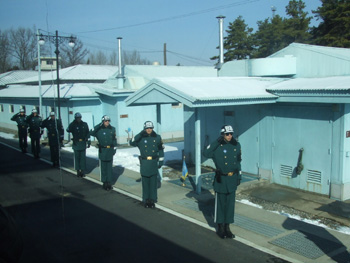
As I have recounted, on my way home to see family in Australia in December I stopped in South Korea for a few days. The trip was principally a city break: I had a look around Seoul. Seoul was in many ways very impressive, but it was also a city striking in its normality. It is a modern, technologically advanced city. The subway system works extremely well. There are McDonald’s and Starbucks outlets everywhere (this is a rare market where a local McDonald’s clone has apparently outdone the original. On the other hand, all Korea’s coffee shops belong to Starbucks). Buildings are modern. People love their mobile phones. Certain Korean brands are perhaps more prominent than they would be in a more balanced economy and they seem to realise this though. Samsung and LG, for instance, seem to market many of their products under local brand names, leading to iconic and very familiar Korean products being present in Korea only under unfamiliar brand names. The city feels extremely safe, it is very clean, and it is about as low stress a place to visit as can be imagined.
The only hint that complete insanity begins less than 50km to the north is only a small one: the fact that uniformed soldiers are to be seen regularly on the streets. There is nothing threatening or remarkable about this. These are just ordinary 19 year old guys in the middle of their compulsory military service. You see them catching the subway, or having lunch in fast food restaurants. These are just young guys going about their lives, who happen to be wearing fatigues. There are many other cities where you will see the same thing. However, now that most developed countries have abandoned compulsory military service, these cities are fewer than they used to be, particularly in countries as advanced as South Korea.
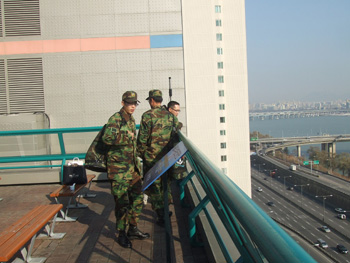
But Korea has retained compulsory military service, and this is because the most heavily defended border in the world lies less than 50km north of Seoul. Of course, I had to go to see it. One can only go into the Demilitarized Zone by going on an organised tour. These are run by both the local USO and by local Korean tour companies. The guidebook recommended the USO tour as “the best tour” but the days on which it ran were not convenient with my schedule, so I booked myself on one of the locally run tours. This turned out to be just fine. However, perhaps because most English speakers go on the USO tour, English speakers were in a minority on this tour. Most of the people on the bus were Japanese. Only six of us were English speakers (myself, three Singaporeans, and an American engineer based in Seoul who was on the tour with his adult daughter who was visiting him for Christmas). There was also a Korean couple. This is apparently rare. Korean civilians are not normally allowed in the DMZ, and those that wish to go on the tour have to apply six months in advance, in which time a thorough background check is undertaken on them, apparently to make sure they are not the sorts of people who are likely to wish to defect to North Korea or otherwise allow the enemy to gain propaganda points (this seems like a deeply peculiar thing to do, but apparently once in a while someone is nutty enough to want to try it). In any event, their presence on the tour was apparently quite unusual, as the English speaking guide remarked upon their presence. And of course, there was no ‘Korean speaking guide’ (although the guides were both Korean and thus clearly spoke the language). The tour was conducted in Japanese and English, and the English and Japanese speaking guides took turns to speak.
When you drive north from Seoul, you realise what a huge metropolitan area the city is at the centre of. (It depends how you measure it, but there is a case for Seoul as the second largest city in the world, which is doubly impressive given that the population was reduced to a few hundred thousand during the Korean War). Urban areas and manufacturing centres are beside the road almost all the way to the border (the LG/Phillips LCD display factory is no more than 10km from the DMZ, so our flat screen television supply is one of the first things we shall lose upon the start of World War 3).
As we drove north the guides gave us various useful pieces of information, such as that we should not run off into the bushes “as there are many minefields”, and that it was very important that we not taunt or gesture at any North Koreans, as if we did they would take our photographs and use them for propaganda purposes against the free world (also, our tour would likely be terminated immediately).
Then we crossed the river Imjin,and normality ceased. This is not the start of the DMZ, but it is the start of what may be referred to as the ‘Militarized Zone’, which is a controlled area occupied by South Korean troops and their weapons. Our passports were checked as we entered this zone, and we were not permitted to take photographs as we went through it. The bridge across the river had barriers across it, compelling all traffic to take a zig-zag route across it, presumably designed to slow down any North Korean invasion. After driving across it there was another fenced border, and passports were checked again (this time by a soldier in a United Nations uniform, but still a Korean) before we entered a region technically under United Nations (in practice United States) command rather than South Korean command.
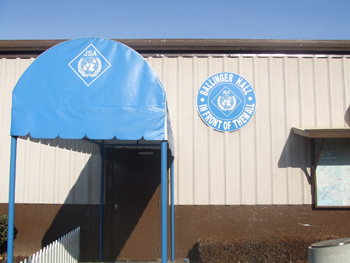
The tour was technically of the Joint Security Area (JSA), in the area of the former village of Panmunjom, which is the only place in the DMZ at which soldiers from the two sides actually face one another. This is where the truce was signed at the end of the Korean war in 1953. In that truce, the so called ‘military demarcation line’ was drawn, marking where the zones of northern and southern occupation met when the ceasefire occurred (for practical purposes this is the border between North and South Korea, but as no peace treaty has ever been signed, the war technically goes on and both countries lay claim to the entire peninsula). The DMZ is approximately 4km wide, but it is divided, half of it lying technically in North Korea and the other half technically in South Korea.
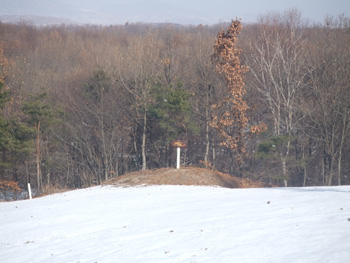
Rusting and deteriorating signs (in English and Korean on the south side, and in Chinese and Korean on the north) and marker posts indicate the demarcation line. In practice, most of the DMZ has not been entered by people in 50 years. In that time certain populations of animals have flourished in this human free environment, despite deer and bears losing occasional limbs to landmines. Some people claim that there are also leopards and tigers in the DMZ, although nobody seems able to confirm this.
However, the JSA is a small area which is occupied, and in which soldiers on the two sides look at each other, and in which negotiations between north and south Korea sometimes occur.
Prior to entering the DMZ and the JSA, we stopped at Camp Bonifas, the closest US post to the DMZ itself. Here we went into a briefing room where we were given a brief history of the Korean war, told what we were allowed to do and not do in the JSA, and were asked to sign a fairly ludicrous disclaimer in which we again agreed not to taunt the North Koreans, not to (with one exception that I will get to in a moment) under any circumstances walk across into North Korea and in which we agreed that we would not hold the United Nations, the United States of America, or South Korea responsible in the event of enemy action. We were given coloured badges to wear in the DMZ indicating that we were guests of the United Nations, and we were joined by an American military policeman who by his accent sounded like he came from the midwest somewhere. We were required to get onto an entirely different bus from that we had ridden from Seoul, presumably to prevent us from smuggling weapons into the DMZ, or smuggling iPods to Kim Jong Il, or something.
Anyway, it was time to enter the DMZ. We were once again not allowed to take photographs on this portion of the journey, but we had soon reached the JSA and Panmunjom. The first stop was the ‘conference room’, one of a number of huts that straddle the demarcation line, in which negotiations between north and south have taken place at various times over the decades. The line goes down the centre of not just the hut but the conference table in the centre of it, and indeed down the middle of the soldier who stands perfectly still at the end of the table
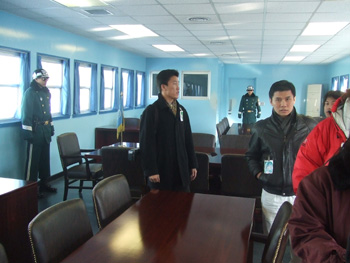
The conference room is the only place in the DMZ which is occupied by people from both North and South Korea, although at different times. North and South Korean tour groups enter it from different doors and at different times, but both visit the same place. In the room, one can and does technically enter North Korea. Prior to the axe murder incident of 1976 (which I shall get to in a moment), soldiers from both North and South Korea did simultaneously occupy the entire area, but after that event they agreed to stay on their own sides of the demarcation line, except in the conference room.
I mentioned a soldier standing perfectly still. In fact, a number of soldiers stand perfectly stationary at various places in the conference room, for our security, at least theoretically. We were told in the briefing room that soldiers have to stand stationary for several hours at a time, and that it is a very stressful job. I can imagine that it is, and it is made more stressful by tour groups entering the room and posing for photographs beside the soldiers, as they do, and as I did. The situation seems not unlike the guards outside Buckingham Palace, except that those are purely ceremonial, whereas these are…
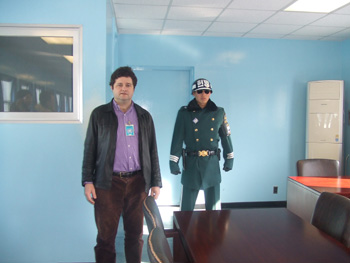
I am technically standing in North Korea. The door behind the soldier leads to the Hermit Kingdom proper
These are what, precisely? I am not sure of the answer. The Buckingham Palace guards once performed a useful function, and over time the useful function eroded, so only the ceremonial and symbolic aspects remained. In the case of the soldiers in the conference room. There is certainly some useful function here. If I attempted to exit the conference room via the North Korean door, the soldier would certainly prevent me from doing so. This was explained to me in the briefing room. It was also explained that we should not walk directly between the soldier and the conference table, as this would obstruct his ability to do his job. One of the Japanese tourists forgot this, and when she moved in front of the soldier his arm moved rapidly down to obstruct her, and the Japanese speaking tour guide launched into a tirade of Japanese aimed at the tourist.
However, one gets a sense that there is a lot of ritual involved even here. When armies are stationed in places where they are at peace for years or decades, the role of ritual grows. The threat of a war is of course extremely real in Korea, and huge armies are poised for action at a moment’s notice. But none the less when you take a photograph the ritual seems to dominate. Perhaps it does so to hide how terrifying the situation actually is. North Korea is truly unpredictable. One really does not know what the North Koreans might do at any moment. So one keeps doing what one has done for the last 50 years. The DMZ is not ultimately going the way of Buckingham Palace. At some point, peacefully or not, the stalemate in Korea will end, and there will no longer be any soldiers standing stationary in conference rooms. One cannot imagine that anybody will want to celebrate the history of the DMZ by maintaining the rituals. But for now the ritual seems old and fixed.
The other peculiar instruction we were given in the briefing room was that we were not to look behind us into North Korea under any circumstances when leaving the conference room. Apparently our photographs would be taken by North Koreans and these could be used for propaganda purposes if we did this. Or perhaps we would turn into pillars of salt, I really do not know. I am not sure they said exactly why. In any event, the threat of another tirade of Japanese was enough to prevent me from doing it. Once we had walked away from the conference room, we were taken through the large ornate building on the South Korean side to a viewing platform, where we were permitted to look at the north and take photographs.
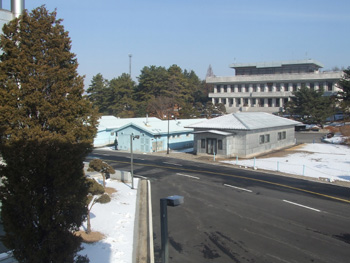
Large ornate buildings face the spartan huts containing the conference rooms from each side. I do not think they have any real function other than to look impressive. Watch towers sit along both sides of the demarcation line, white for North Korea and blue for the South Korean side – presumably indicating a UN operation. The guide told us that the nearby North Korean watch tower would certainly contain soldiers taking our photographs.
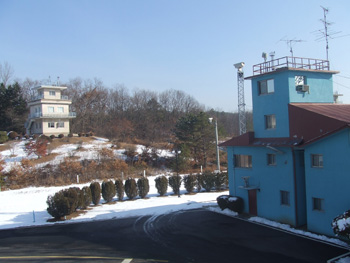
Behind us (the JSA is on a tongue of land sticking into North Korea, and is surrounded by North Korea on three sides) it was possible to see Gijeong-dong, the so called ‘Propaganda Village’, the North Korean village in which nobody apparently lives (lights come on in some of the buildings – but at the same time every day), but which does contain the world’s largest flagpole, which holds a very large flag that needs to be taken down very quickly when it rains, as when wet it is likely to become heavy enough to cause the flagpole to collapse.
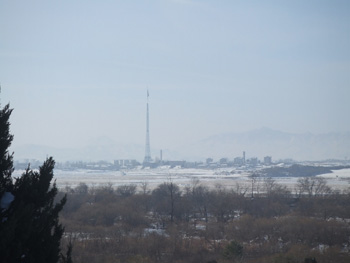
Thankfully, the village no longer broadcasts North Korean propaganda through enormous speakers, although it did for quite a few years. The world’s second largest flagpole (the South Koreans eventually conceded to the North after a period of competitive flagpole building in the 1980s) is situated in Daeseong-dong, the so called ‘Freedom Village’ (these names are given by the South Koreans, obviously) in the southern part of the DMZ, just south of the JSA. In various places one can see white marker posts separated from each other by a few metres, that denote the demarcation lines.
There were two final things to see in the JSA. For these we were not allowed to leave the tour bus. Firstly, the memorial to Captain Arthur Bonifas, after who the UN camp is now named, It was formally Camp Kitty Hawk, but was renamed after the murder of Captain Bonifas by the North Koreans.
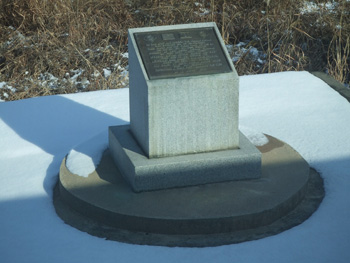
In 1976 Bonifas and a group of five American and South Korean Soldiers attempted to chop down a tree in the JSA which was obstructing the view of the Bridge of No Return into North Korea. Northern Korean soldiers demanded that they stop, and when the Americans and South Koreans refused to do so, the party was rushed by North Korean soldiers, and after a skirmish Captain Bonifas and Lt. Mark Barrett were murdered by their own axes. This incident led to the ending of the situation where both North and South Koreans were able to move freely in the JSA, and is the most serious incident to have occurred in the JSA (US and South Korean soldiers completed chopping down the tree a few days later in ‘Operation Paul Bunyan’).
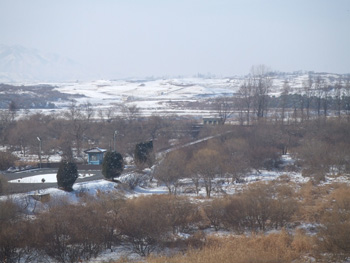
The memorial is actually just visible in the bottom left of the above picture. The bulk of the picture shows the Bridge of No Return, which was the final stop of the tour in the DMZ. This has been used for prisoner exchange at the end of the Korean War and at various times since. The name emphasizes the fact that at the end of the war, prisoners were given the option of returning home or remaining with their captors, and made the decision by choosing whether or not to cross the bridge, and any such decision was final. If you crossed it into North Korea, there would be no option of coming back. I suspect that if I had somehow managed to leave the tour party and crossed it I would not have been allowed to return either. However, I was not given the option of going any where near it. The tour guide explained that this was by far the most dangerous place on the tour, and that this explained why we were not permitted to leave the bus.
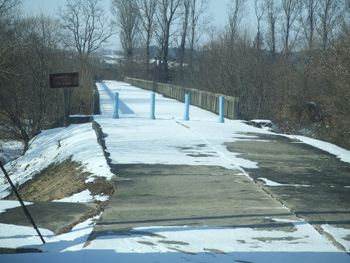
This was more or less the end of the tour. However, it is one of the inviolable laws of the universe that all bus tours include at least one trip to a gift shop, local craft shop, etc, at which tourists are encouraged to buy souvenirs, and the tour company generally paid a commission on anything sold in the shop. As I then discovered, this even applies on tours of the Demilitarized Zone between North and South Korea. That’s right, the demilitarized zone has a gift shop. Really.
Well, almost. The gift shop is actually outside the DMZ, inside Camp Bonifas on the southern side (I have no idea if there is a gift shop on the North Korean side where one can buy fetching portraits of the Dear Leader. Probably). But the souvenirs mostly commemorate the DMZ itself. I looked around. Korean staff wearing fetching leather jackets with a ‘JSA’ insignia attempted to sell us stuff. There were all the usual things one can buy in gift shops. Coffee cups. T-shirts and sweat shirts. Tea towels. Jigsaws. Baseball caps. All fairly mundane, despite the oddness of the place being commemorated. I don’t normally buy these sorts of things, but somehow the DMZ gift shop was special. I looked for the oddest possible souvenir to buy
And in the glass case that made up one of the counters was the perfectly bizarre souvenir.
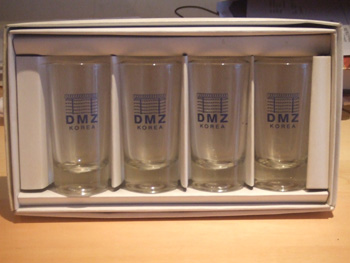
Yes, it is a set of DMZ souvenir shot glasses. I particularly like the barbed wire. Of course, I had to have them. In any event, the set only cost me about $5. And I think they now have clearly taken first place in the list of the strangest of my few earthly possessions.
Everybody I have shown my set of DMZ souvenir shot glasses to has wanted a set for themselves. I should have bought about ten, and I would have a year’s worth of birthday presents. They are the perfect glasses to fill with strange distilled rice spirits and raise to liberty and freedom.
But that was it. As we drove back into and through South Korea, the English speaking guide had an informal chat with us, asking why we were in Korea and suggesting things that we might do in Seoul. We asked her about the South Korean attitude to possible reunification, and she told us that South Koreans generally did not want it. “Germany tried it, and they almost sent themselves bankrupt. We do not want that, although obviously we would prefer to have a normal, peaceful country to our north”.
Personally, I am not sure that is the right interpretation of the German situation. Certainly, the implementation of German reunification has been disastrous, but I do not believe that this is a problem with reunification per se, as much as the way in which the Germans actually went about it. The advantage that East Germany should have had post-reunification was a cheaper and more flexible labour market than the west, although with lower productivity. By forcing western wages and the western welfare system on the east (and by spending lots of public money on infrastructure, which generally flowed back west because that was where the expertise to built it lay), the Germans created a system that looked generous in the short term (and which was horribly expensive for the west) but which in the long term only led to high unemployment and a business environment that no sane private sector company would choose to invest in. There is no reason whatsoever why Korean reunification would have to make the same mistakes. It would be a shame if the reaction to German mistakes was to swing so far in the opposite direction that entirely different mistakes were made.
However, this lies in the future. The fall of North Korea does not look imminent. That said, these things do tend to happen at unexpected moments. It will happen sometime. The question is simply when. More importantly, the question is how. It does not need to be said that another war on the Korean peninsular would likely be catastrophic.
But for my tour, that was it. After a quick stop for lunch, it was back to Seoul and normality, looking for a nice restaurant in which to eat dinner.
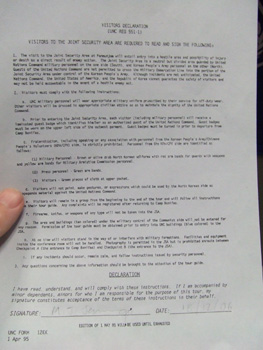




Fascinating.
Brilliant post, thanks 🙂
Thank you, that was quite illuminating.
Fabulous essay Michael. Thanks
I’ve read an essay or two about people visiting the DMZ from the north and the comparing those with this essay, what seems interesting is that making the trip from the other side doesn’t especially seem that much more restrictive than the rest of the country.
That is, tourists to the DPRK are told what to do and what not to do (and what not to take pictures of etc) the entire time and so the trip to the DMZ is just more of the same rather than a jarring trip into another reality.
Michael:
You’ve been commenting brilliantly on my blog for so long now that it’s now a great pleasure to see your work in extended format. I have already linked to my blog. I do have one question: You say that NK will eventually “fall.” Do mean collapse like Soviet Germany, or do you forsee an all-out war with South Korea/America?
Michael, it was great to see your collection of Korean photos on Friday evening and this is a really good post mate. Very informative. Myself and my wife really want to do the “Big Asian Tour” someday and this helps wet the appetite.
Have you seen the movie JSA?
Good article.
A mate of mine has travelled (in the course of various trips) from Scotland to Pusan overland. The final link was walking around the table, having entered from the NK side.
Fascinating, Michael. Thank you for taking the time to illuminate the goings-on in this part of the world in such detail. Your account was highly readable.
I shall now have to persuade the wife to let us go take a look…
Good post!
We asked her about the South Korean attitude to possible reunification, and she told us that South Koreans generally did not want it.
Interesting, because the South Koreans I met in Seoul generally seemed to want unification, seeing all Koreans as being the same (much as East and West Germans were). A few of them thought this would take place within 15 years.
It might be the nature of her job as a tour guide. I am sure the subject comes up a lot, and talking about Germany is the obvious thing to do when it does. Unfortunately the German example is not a very positive one, at least not from an economic perspective, and this is reflected in the answer.
The Koreans are always very eager to tell you about the immense age of their distinct nation, with ages of up to five thousand years being brought up. Next to that, I would doubt they see fifty years of division as very much, and I tend to think that popular support for reunification would be strong. Whatever differences exist between north and south, I think the sense of “We are Korean. We are not Japanese. We are not Chinese” is likely to be very strong in both places.
However, the South Koreans and the technocrats who built the modern South Korean industrial state are (justly) very proud of having brought the country from the poor world to the rich in an extremely short period of time. Reluctance to do anything that they think might damage their economy is quite understandable. However, I think the particular mistakes that were made by the Germans are quite clear and quite avoidable. Hopefully the Korean technocrats understand this too.
As for timing, the Germans went from the wall falling to reunification in less than a year. When these things happen they can go from seeming unlikely to fruition in astonishingly short periods of time. So seeing it happen some time in the next 15 years strikes me as perfectly plausible, although I have no idea exactly how and when it might happen.
Looks different than it did in October of ’50.
I’m not sure German re-unification has been such a disaster. Give ’em time.
We’re not just talking fifty years of Commie misrule here. I assume the DDR was never properly rebuilt following WWII. Oh, and brown coal.
When NK fails completely I’m not sure re-unification is entirely certain. The Chinese will want to keep their finger in that particular pie. SK will end up directly bordering a post-communist Chinese fiefdom or (if re-unified) bordering China itself. Given the current Chinese military build-up you can’t fault the SKs for being cautious about the whole thing. Especially given that if there is a war it is likely to be incredibly brutal and Seoul is likely to take a pasting.
Fascinating article Michael. Just one further point I’d take up. The soldiers at Buck House still have a “useful purpose” – they pull in the tourists.
They want reunification as long as we Americans foot the bill.
“On the other hand, all Korea’s coffee shops belong to Starbucks”
Not really true. In fact, Starbucks is currently involved in a lawsuit against a South Korean company called Starspreya. You can read about it (and many other South Korean related issues) here
*sigh* preview is your friend! i mean to say:
starbucks is currently involved in a lawsuit against Starspreya, a South Korean coffee chain company it (starbucks) claims stole it’s logo.
Not really true.
No, indeed it isn’t. I had a few coffees in the “Ediya Espresso” chain. Also, the Japanese “Doutor Cofee” chain seemed to have a few outlets. Amongst others. But still, there are *a lot* of Starbucks outlets.
In truth I when I wrote the post I worded this differently so as to make a joke (something along the lines of “All our coffee shops are belong to Starbucks”, to suggest that Starbucks’ arrival in Seoul had perhaps resembled an alien invasion) and our esteemed editor either thought it wasn’t a very good joke or thought it was an error, and thus changed it.
When NK finally implodes there will be some 25 million starving North Koreans to feed and to prevent from moving south en masse. Quite a problem. The guide had a point when she said that SK is likely to keep the DMZ for a while….. As far as SK is concerned, it would be better for them to leave NK as a separate entity, at least for some decades, until they catch up.
I just hope the PRK survives long enough for me to take a trip to South Korea and buy myself a set of those shot glasses.
Out of curiosity: did they say whether building new structures in the JSA is allowed? You’d think that the North Koreans, at least, would want their stuff to look more impressive (every US military installation I’ve ever been in or near has looked exactly like the buildings you photographed; they’ll keep it like that till the whole place is razed.) On the other hand, I’ve noticed an odd tendency for Communist countries to spend comparatively small amounts on diplomatic structures seen by the west (when I visited the Chinese embassy in Washington, for the 50th anniversary of the PRC, they hadn’t even paved their parking lot,) as compared with what is spent on their lavish internal celebrations. Maybe everyone’s just okay with the shacks as they are.
The blue huts visible in the first, sixth (from the inside), seventh (inside again) and eighth photographs actually straddle the border, and belong jointly to both sides. Therefore they are in an extraordinarily sensitive place, and nobody would want to touch them. (I have no idea who paints them and provides maintenance).
The two sides can build structures on their side of the line. However, there are restrictions on the number of people from each side who may be in the JSA at any one time, and I suspect that heavy construction equipment would be frowned upon if not prohibited outright, so I doubt any large program of construction would be a great idea or indeed possible. (This is a very sensitive place. Two men were once murdered with axes when they attempted to chop down a tree. In another incident a bystander was shot and killed when the North Koreans opened fire when somebody defected from the north to the south. And there have been a lot of other incidends over the years, from fistfights to exchanges of rude gestures to people using the flag of the other side to polish their boots. Nobody wants to do anything that might provoke an incident. None the less, there are buildings with more impressive facades on each side facing the huts. The north Korean building is visible in the eighth photograph, and there is a similar one on the South Korean side.
Beyond the facades, though, there is very little point. Nobody ever enters buildings belonging to the other side. Nobody even sees the back of the ones on the North Korean side. (It is probably possible to see the back of the South Korean one from North Korea due to the shape of the border.
Camp Bonifas is a little to the south, and no North Korean ever sees or visits it, so there is little point in trying to make it look impressive. As you would probably expect, it just looks exactly like any other US military installation anywhere else.
An interesting read, thanks
Having been stationed within the DMZ area (Camp Greaves) and on both U.S. Outposts (Collier and Outlette) it brought back many memories. It is indeed very tense and we never let our guard down. Living and breathing it 24 hours a day does get to you but, having your fellow soldiers around you makes it bearable.
Thank you for the memories.
Frank
wow.. interesting..
I’m from South Korea bt I’ve never visited there.. mayb I will when I have to serve for the millitary later. lol
Thx for the great post!
I was in Seoul for a one-year tour with the US Army from 9/97-9/98. I had a wonderful experience there! It looks a lot different even now from your pictures. As soon as I reported to my stateside assignment, I wanted to be back in Seoul! Even soldiers treat one another better in the USFK than they did in my subsequent stateside unit! I loved the coffee shops there, and the subway/train systems! Unforgettable in a very good way!
Hi Thx for the tour. Pretty errie feeling been there in amongst the tension I bet.
Im for democracy hard core! I feel sorry for all the children in Nth Korea dying of starvation, Its not right at all!!
Cheers from NZ
I was stationed at Camp Liberty Bell (across the road from Camp Bonifas), as a Light Weapons Infantryman in 73 – 74. I did patrols inside the “Z” and guard duty on Outpost Collier and Outpost Oullette. Scary stuff. I remember North Korean soldiers staring at me and me them. Interesting take on the whole thing as I never did get to go inside Panmunjom only observed it from a distance during my tenure there.
1/31st Bearcats Mechanized Infantry , 2nd Infantry Division
Ed Robinson